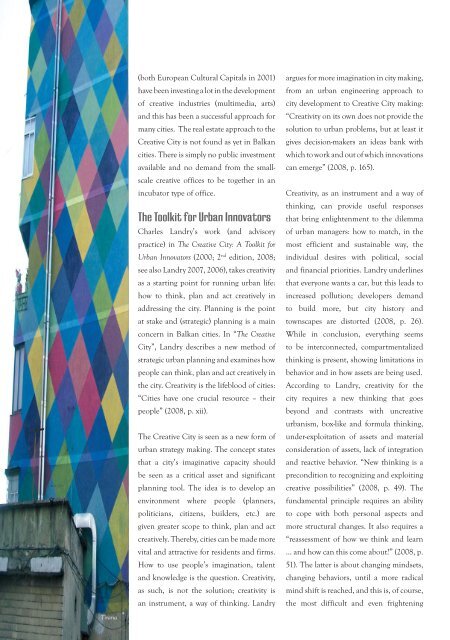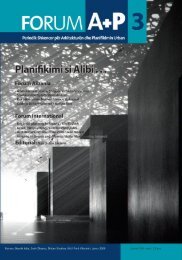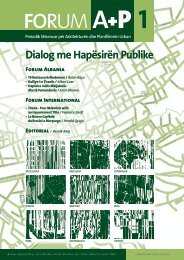Forum A+P 02
POLIS University publishes the “Forum A+P” journal, the only scientific and cultural magazine in the Albanian –speaking countries for the fields of architecture and territory planning. This magazine is recognized by the Ministry of Education and Science, the Academic Degrees Evaluation Committee and has an ISSN international registration code in France. The magazine is published in Albanian and English language and contains a package of scientific, informative articles and analysis.
POLIS University publishes the “Forum A+P” journal, the only scientific and cultural magazine in the Albanian –speaking countries for the fields of architecture and territory planning. This magazine is recognized by the Ministry of Education and Science, the Academic Degrees Evaluation Committee and has an ISSN international registration code in France. The magazine is published in Albanian and English language and contains a package of scientific, informative articles and analysis.
You also want an ePaper? Increase the reach of your titles
YUMPU automatically turns print PDFs into web optimized ePapers that Google loves.
114<br />
Tirana<br />
(both European Cultural Capitals in 2001)<br />
have been investing a lot in the development<br />
of creative industries (multimedia, arts)<br />
and this has been a successful approach for<br />
many cities. The real estate approach to the<br />
Creative City is not found as yet in Balkan<br />
cities. There is simply no public investment<br />
available and no demand from the smallscale<br />
creative offices to be together in an<br />
incubator type of office.<br />
The Toolkit for Urban Innovators<br />
Charles Landry’s work (and advisory<br />
practice) in The Creative City: A Toolkit for<br />
Urban Innovators (2000; 2 nd edition, 2008;<br />
see also Landry 2007, 2006), takes creativity<br />
as a starting point for running urban life:<br />
how to think, plan and act creatively in<br />
addressing the city. Planning is the point<br />
at stake and (strategic) planning is a main<br />
concern in Balkan cities. In “The Creative<br />
City”, Landry describes a new method of<br />
strategic urban planning and examines how<br />
people can think, plan and act creatively in<br />
the city. Creativity is the lifeblood of cities:<br />
“Cities have one crucial resource – their<br />
people” (2008, p. xii).<br />
The Creative City is seen as a new form of<br />
urban strategy making. The concept states<br />
that a city’s imaginative capacity should<br />
be seen as a critical asset and significant<br />
planning tool. The idea is to develop an<br />
environment where people (planners,<br />
politicians, citizens, builders, etc.) are<br />
given greater scope to think, plan and act<br />
creatively. Thereby, cities can be made more<br />
vital and attractive for residents and firms.<br />
How to use people’s imagination, talent<br />
and knowledge is the question. Creativity,<br />
as such, is not the solution; creativity is<br />
an instrument, a way of thinking. Landry<br />
argues for more imagination in city making,<br />
from an urban engineering approach to<br />
city development to Creative City making:<br />
“Creativity on its own does not provide the<br />
solution to urban problems, but at least it<br />
gives decision-makers an ideas bank with<br />
which to work and out of which innovations<br />
can emerge” (2008, p. 165).<br />
Creativity, as an instrument and a way of<br />
thinking, can provide useful responses<br />
that bring enlightenment to the dilemma<br />
of urban managers: how to match, in the<br />
most efficient and sustainable way, the<br />
individual desires with political, social<br />
and financial priorities. Landry underlines<br />
that everyone wants a car, but this leads to<br />
increased pollution; developers demand<br />
to build more, but city history and<br />
townscapes are distorted (2008, p. 26).<br />
While in conclusion, everything seems<br />
to be interconnected, compartmentalized<br />
thinking is present, showing limitations in<br />
behavior and in how assets are being used.<br />
According to Landry, creativity for the<br />
city requires a new thinking that goes<br />
beyond and contrasts with uncreative<br />
urbanism, box-like and formula thinking,<br />
under-exploitation of assets and material<br />
consideration of assets, lack of integration<br />
and reactive behavior. “New thinking is a<br />
precondition to recognizing and exploiting<br />
creative possibilities” (2008, p. 49). The<br />
fundamental principle requires an ability<br />
to cope with both personal aspects and<br />
more structural changes. It also requires a<br />
“reassessment of how we think and learn<br />
… and how can this come about?” (2008, p.<br />
51). The latter is about changing mindsets,<br />
changing behaviors, until a more radical<br />
mind shift is reached, and this is, of course,<br />
the most difficult and even frightening





